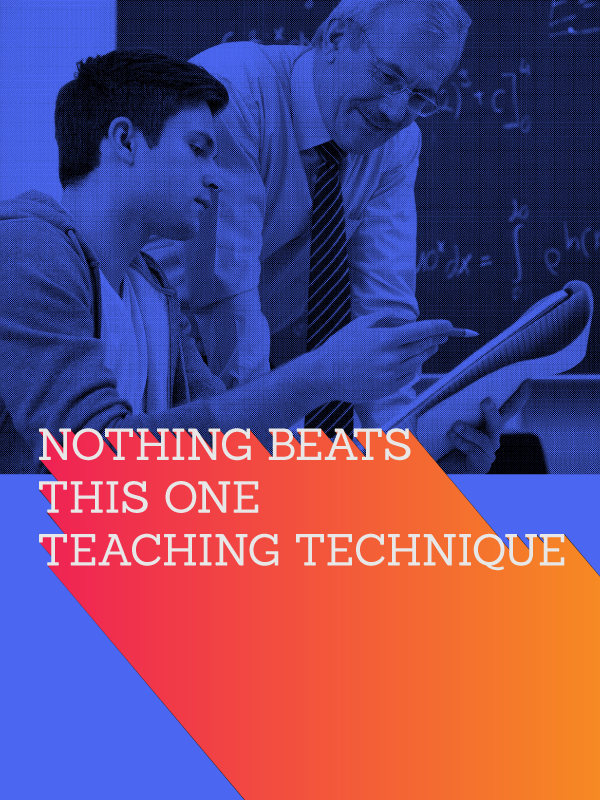Nothing Beats This One Teaching Technique


When I first started teaching, just hearing the words “formative assessment” filled me with a sense of inadequacy and worry. I wanted to be as effective as possible, but how could I begin to track where every single one of my students was in the learning process on a day-to-day basis? How could I possibly provide each of them with the kind of daily individualized instruction shown to be most valuable for learning? Before GradeCam, assessing and teaching formatively seemed impossible.

A little quiz for you:
Choose one. Research shows that teachers achieve the greatest learning gains when they
a) Provide ongoing feedback to help students identify their strengths and weaknesses
b) Address student misunderstandings as soon as possible
c) Continually adapt their instruction to meet each student’s unique needs
d) Reflect on how what they are doing is affecting student learning
e) All of the above
Too easy, right? Since a, b, c, and d are all components of formative assessment, e is the correct answer. Hundreds of studies show that utilizing formative assessment is the most effective teaching strategy that exists.
Truth is, I don’t think it is possible to do all of the above without a tool to help. In fact, I believe it is unfair and unrealistic for others to expect teachers to be able to do a, b, c, and d every day – or even most days – without something that helps them see their students’ thinking in real time. For me, GradeCam was that something, and it made formative teaching not only possible, but easy, natural, and even fun. I’ve talked to hundreds of teachers since then who’ve claimed the same.
If you haven’t already unleashed GradeCam’s powerful formative assessment capabilities and want to, here are the three most important things you need to do:
1) Quiz your students frequently.
You want to see information on what is being learned as often as possible.
2) Have your students scan their quizzes themselves.
Timing is a critical factor in the formative assessment process. The sooner your students and you get feedback, the more potential it has to affect learning.
3) Put the real-time reports GradeCam provides to work right then and there.
Again, timing is crucial. You want to reinforce learning and close gaps in understanding while students are still connected to the material. In fact, studies show that your re-teaching window is only about two hours if you want to get the biggest instructional payoff.
I’ve talked to many teachers who are masters at that last one, teachers who have devised brilliant, creative ways to utilize GradeCam’s instant reports to super-charge learning.
My normal approach was usually pretty simple. Most often I used the item analysis to see which questions I needed to re-teach and used the details to generate class discussions. (Example:Why do you think almost everyone who missed Question #3 chose such and such for their answer?) My goal, of course, was to see my students’ thinking and use it to drive my instruction.
I also frequently took a quick look at one of the reports that showed each individual’s results, identified those who needed extra help, and then conducted timely short one-on-one lessons.
Another great advantage I gained from the instant feedback was the ability to tell how well I had just taught a concept or standard, or whether I had even taught it at all. I was surprised more than once to find out I obviously hadn’t!
Of course, GradeCam is a great tool for lots of reasons. I love that it makes giving summative assessments quick and easy too and that it helps teachers manage their massive paperwork loads while saving time and relieving stress. What brings me the greatest pride, though, is that for thousands of teachers, doing a, b, c, and d is now possible.
 Tami Porter is the co-founder of GradeCam. Tami began her teaching career in 1998 where she quickly found herself buried in paperwork with not enough time for lesson planning. When scanning groceries at a grocery store, she wished grading papers could be just as easy. She took her idea of scannable assessments to her entrepreneurial family – sons Rich and Rob, and husband Rick – and the family business was born.
Tami Porter is the co-founder of GradeCam. Tami began her teaching career in 1998 where she quickly found herself buried in paperwork with not enough time for lesson planning. When scanning groceries at a grocery store, she wished grading papers could be just as easy. She took her idea of scannable assessments to her entrepreneurial family – sons Rich and Rob, and husband Rick – and the family business was born.




